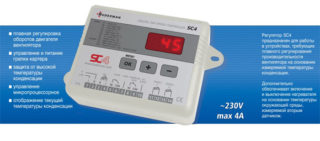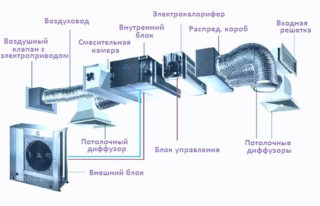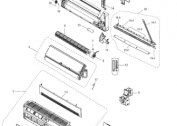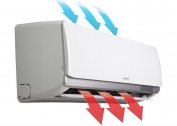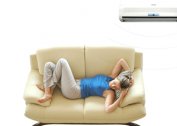To choose the right split system, you need to know what technical characteristics of the air conditioner take into account how they affect energy consumption and comfort.
The most common type is wall-mounted, so most of the technical parameters will relate to household models. Office, industrial air cooling systems have approximately the same characteristics, so you can navigate this list when choosing a unit for large rooms.
What are air conditioners
Each model has its own characteristics of work. They are taken into account so that during the operation there is no dissatisfaction with the device. The market offers new developments, but without knowing what and how it works, choosing the right climate technology will fail.
Invertor Climate Systems
 The inverter type of air conditioner allows you to maintain the same temperature, but the device does not turn off completely, but switches to low power mode:
The inverter type of air conditioner allows you to maintain the same temperature, but the device does not turn off completely, but switches to low power mode:
- the rotation speed of the fan blades is reduced;
- reduced compressor and heat exchanger performance.
The advantage of this type:
- energy is saved up to 30%;
- service life is increased by 50%;
- makes less noise;
- device parts do not wear out.
When starting a conventional air conditioner, a large load falls on the network and the compressor. Inversion allows the mechanism to work continuously, independently simulating the indoor climate.
With the possibility of heating
Such split systems are more expensive, but at a temperature in the street from 0 to +10, they can heat the apartment. Such equipment has many advantages:
- dries the air, preventing mold from forming on the walls;
- saves energy thanks to automatic temperature settings;
- emits 3-4 times more heat than it expends.
Minus the “warm” air conditioner at a high cost. In the cold season at sub-zero temperatures, equipment without a winter kit cannot be turned on - this leads to equipment breakdown.
Availability of winter kit
There are many myths about heating a room with air conditioning. Here are the main ones:
- With a winter kit, you can fully heat the apartment: not a single air conditioner will heat the air even up to 19 - 20 degrees, if the window is minus 20.
- At any temperature, split systems work as always: efficiency in winter at low temperatures decreases by a factor of 3-4, so you can’t expect full-fledged work for heating.
- A winter kit is needed for heating in winter: the device protects the air conditioner, which is turned on in winter to cool rooms in which it is always hot and requires heat dissipation.
- With a built-in winter device, the split system can always be turned on: it serves to protect in the off-season from night frosts.
For heating, it is better to use convectors or other systems. They are much cheaper than air conditioning, so it’s not worth the risk.
Description of technical characteristics
The main parameters of the air conditioner are associated with cooling and power consumption. These are two different indicators, so you need to distinguish what is written in the device passport.
Power consumed by the air conditioner
This parameter means how much electricity is needed for a certain period of time. In good air conditioners, this figure is three times less than the cooling capacity.
There are two different systems according to which the manufacturer indicates the energy efficiency of the device - this is the energy efficiency coefficient ERR and the thermal coefficient COP.The numbers indicate the ratio of cooling or heating power to consumed. The quality of cooling is determined by 7 categories - from A to G, where energy class A is the highest, G is the lowest.
In 2013, SEER and SCOP introduced seasonal energy efficiency indicators. They are used for climate systems with cooling capacity up to 12 kW. Quality classes are designated: A +++, A ++, A +, B, C, D.
Cooling power
The main indicator of work, on which depends how comfortable the stay in the room will be. It is calculated based on the area to be cooled. Usually, a specialist from the company leaves the facility in advance and carries out all measurements.
Ventilation option
Household split systems do not ventilate the air, but only cool the one inside. Only ducted air conditioners built into the ventilation system have this property. Such devices are laid at the construction stage, so it will be problematic to organize ventilation in a room with metal-plastic windows.
Air cleaning
Devices are equipped with fine filters. They filter the air and the fine dust, odors, pollen that settle inside and linger. The service life of the fine filter is up to 2 years, then a replacement is required. In fact, this function does not always work well. Studies to what extent air conditioners purify the air have not been conducted. Therefore, for cleaning, you need to use other devices, in the passport of which you can find out how effectively this procedure is performed.
Auto mode
Designed for self-regulation of the internal temperature of the air conditioner using sensors. The device can switch to heating or cooling mode without human intervention, following the settings on the control panel.
Air flow direction
In some models, the curtains move up and down, evenly distributing the flows. To prevent the cold air from reaching people in the room, they usually automatically go up. In the heating mode, on the contrary, it is downward, since warm air tends upward and, while rising, manages to heat the space.
Timer
The function is intended for inclusion at the appointed time, for example in the summer, when you need to cool the room at the arrival of the owners.
Fan speed
Models are equipped with a 3 or 5 step fan. This means that the speed will vary depending on the degree of cooling. The price of three-stage models is lower.
Night work
 The night mode is set automatically if you make the necessary settings through the remote control. At night, the fan speed decreases and the noise level decreases.
The night mode is set automatically if you make the necessary settings through the remote control. At night, the fan speed decreases and the noise level decreases.
Type of freon
In air conditioners, the classic version of freon - R22 can be used. It is cheaper, therefore, it is used in low-cost models. R410 is safer from an environmental point of view, since it does not destroy the ozone layer, but for its use a more tight connection of parts is necessary, since the pressure in the system is 30 - 40% higher. In general, there is not much difference between the two brands, but in the model with R22 refrigerant it is impossible to fill in R410, therefore, it is necessary to determine in advance.
Noise level
The quietest indoor and outdoor units are different Japanese fan coil models. In the instructions for a three-speed fan, they usually write three noise levels or one - the smallest indicator. The noise level of a working indoor unit is important for residents who have it installed. External - for residents whose windows go to where the external unit is installed.
With the windows open, the sound of a working device may interfere with neighbors and they have the right to file a complaint.
Climate protection system
The main characteristics of air conditioners include protective functions:
- restart - turns on the equipment after power surges;
- protection of filters from pollution prevents dirt from sticking to the internal parts of the air conditioner, and the corresponding indicator lights up;
- an indicator of a leak of cooling gas - freon - protects the compressor from overheating;
- a current malfunction makes it possible to determine in which state freon enters - in liquid or gaseous. This is a protection against improper use in the winter;
- in winter, the compressor may not turn on if the temperature outside the window is below the permissible level;
- defrosting - occurs automatically if the external unit is covered with ice, the internal unit does not turn on, only the external one works.
In cheap air conditioners there is no protection system. In mid-range devices, there are several levels out of all possible. A complete system is only available in expensive air conditioners.
The price for a complete protection system increases by 30%, but the device lasts longer, since electronic systems do not allow it to work in unacceptable conditions.
